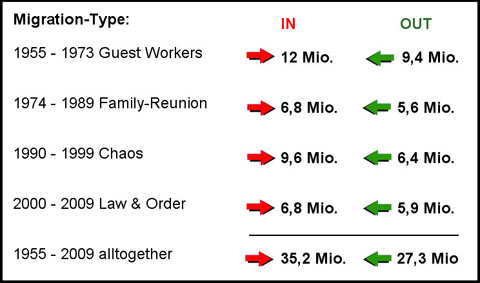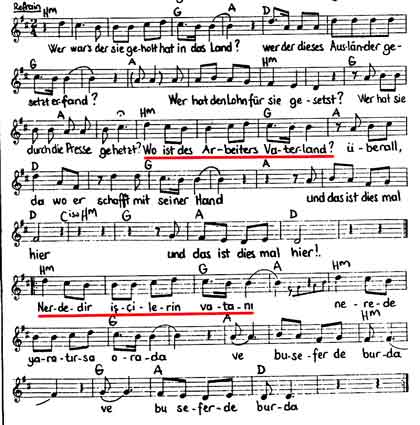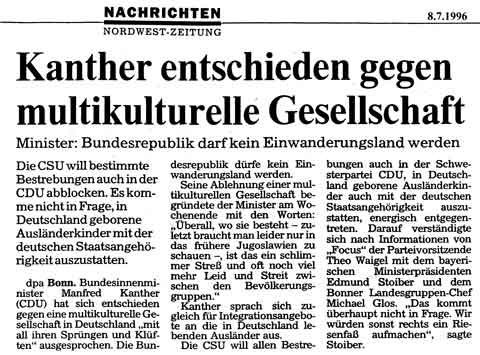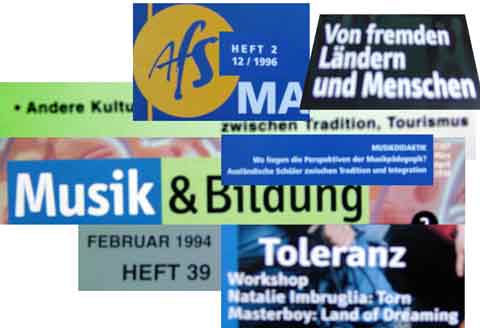1. Concepts of "Intercultural Music Education" as a Response to the Migration in Germany 1955-2010
[This is a 2010-text presented at the EAS-conference in Bolu/Turkey. A more detailed text from 2017 in German is here
(Download pdf).].
Although the German situation of migration offers some special features, I hope that there will
be problems and solutions, which are of an European interest. I refer here to music education in public schools. 9 Mio.
students visit these schools, and among them there are 2.34 Mio. students with a migrant background (and 0.9 Mio. Muslims)
[ 1]. The different concepts of music education, which are concerned with
migration, are a response to the four phases of migration in Germany:

1955-1973 (guest workers)
In the phase of “Guest Workers” 12 Mio. foreigners from Mediterranean countries worked in Germany.
These workers had fixed-term contracts, so that their relatives stayed at home. Therefore there were no foreign
kids in German schools. German popular music shows very highly welcome. The musical life of these guest workers
was completely isolated from the German society, and it took me considerable effort to get a recording of a
Yugoslavian party near Karlsruhe in 1973.
Video 1: Ein kleiner Italiener and field recording.
1974-1989 (family reunion)
The Federal Republic stopped any further recruitment of foreign labor in 1974. 2.6 Mio. guest workers remained in Germany,
among them 0.65 Mio. Turkish. They drew their families into Germany, or started their own families. Thus foreign kids appeared
in public schools. In the 1980’s , we had a vivid foreign subculture, which interacted with the dominant German music
scene within a small politically engaged sector. By 1976 there was the only worldwide Turkish Worker’s choir in Berlin
lead by the exiled composer Tahsin Inciri singing for a German audience. Turkish-German Song-Books were published, for example
one of Zülfü Livaneli (1981). Other song books were printed for the use in Kindergarten and Elementary Schools.
One could also hear bi-cultural concerts within the German left-wing scene:

Music Example: Mesut çobancaoğlu & Frank Baier "Türkçe ve Almanca şarkılar" 1986.
This song deals with the question "where is my home country" (German: "Vaterland", Turkish: "vatandas" for citizenship).
The answer of the German and Turkish musicians, who perform this song in two languages, is: The worker's home country is not there, where he was born,
but there, where he works ... and this is here!" (which means, not in Turkey, but in Germany). The song also refers to the slogan of German
"nationalists", who say, that the former guest workers should leave Germany in order to reduce th unemployment-rate. The musicians Therefore
ask: Who called these guest workers? Who built up Germany after the war? And who made these new laws? etc.
There is a Turkish proverb "Your home country is not there, where Your were born, but there, where You get enough to eat".
In 1993 the Turkish artist Gülsün Karamustafa showed an installation in Istanbul with the title "Heimat ist, wo man
isst" ("home country is where you eat"), showing three spoons, tied together with a gauze bandage.
Many foreign kids were referred to Schools for the Handicapped (Sonderschulen), because of their lack of knowledge of German language.
The music teacher Irmgard Merkt from Dortmund recognized that these kids were not stupid or handicapped. She wrote a book on the situation of “
Turkish-German Music-Pedagogy”, and this was the beginning of Germany’s “intercultural music education”
(IME)[ 2]. Her aim was intercultural communication by musical means. At that time
nobody talked about social integration, as is the case today. This feature corresponded to official guide lines to maintain “the
ability of move back to the homeland” (Rückkehrfähigkeit).
The leading ideas of this IME were transformed into contexts outside public schools. Let me give an example: The “Cultural Cooperative
Ruhr” (Dortmund) organized in some dozen cities music groups called “rüzgargülü”. These groups sang and
performed strictly bi-lingual, and addressed foreigners as well as Germans. They sang songs, which were known by the foreigner’s
children (in Germany), and not songs, which music ethnologists had found in villages of Greece or Turkey. Let me show an example:
the song “dere geliyor dere” first sung by a Turkish child and then a version of a group “rüzgargülü”:
Video 2: “rüzgargülü” - “Dere geliyor dere” field reording and concert
Irmgard Merkt’s concept of IME had almost no importance within the main discourse of German music pedagogy.
The teachers of the 1980’s were engaged in learning how to teach Pop-Music instead of Art-Music. And thus, they had
to learn about Jazz, Soul, Blues, Son, Salsa and other Latin Styles, Afro-Pop and Afro-Percussion. They did not learn about
the music of the main migrant groups living in Germany. Thus they established some kind of “Alibi-IME”.
(This Alibi-IME is predominant up to our days.)
1990 – 1999 (chaos)
Due to the “Wende” 1990 the German Policy concerning migration fell into chaos: between 1991 and 1994 1 Mio. immigrants entered Germany per year, almost half of them from East-Europe, who were called “Re-Settlers” (official term 2008: ethnic German immigrants from Eastern Europe), i.e. persons mainly from Russia whose ancestors settled East in the 18th century. Besides this, the Balkans-wars produced some millions of refugees or asylum seekers. For example, in 1992 there were 0.4 Mio. asylum seekers.
The Federal Government still refused to acknowledge that Germany is a multicultural “immigrant country”, and the Minister of Interior said: “Let’s never become a multicultural society, because this means much pain for the peoples as is the case in the Balkans”. A new notion came into use, the German “guideline culture” (Leitkultur)[ 3]. This notion means more then just follow the German Constitution[ 4], but there was never a clear, non-ideological definition.

In these years German music pedagogy started for the first time an intense discussion on music education within public schools, which are affected by migration and are actually multicultural. This discussion was an intellectual and humanistic reaction to the policy, which was characterized by Chancellor Helmut Kohl’s strategy “wait up, do nothing, and see what will come”.

The concept of IME from the 1980’s was no more sufficient, because this concept had assumed that in a classroom there were only two homogenous groups – Germans and foreigners. But actually there were grandchildren of guest workers (speaking one of the many German dialects), some “re-settlers” from Russia (with German passport but without knowledge of the language), refugees from the Balkans with their war trauma, African children with the typical racist discrimination, Arab asylum seeker’s children (from Lebanon, Iraq, Sudan, Eritrea etc.), “boat people’s” kids from Vietnam etc.
Thus two new concepts were developed within the 1990’s:
(1) The transcultural music education, which addressed all students: the migrants and the non-migrants, the foreigners and the Germans. The aim was not anymore an intercultural communication process but the experience and self-awareness of the “global character” of musics. Thus, the music dealt with was mostly archetypical. Volker Schütz demonstrated his concept by using African Music (“authentic” and “popular”). He said that the “body character” of this music is the basis of the popular music, which all kids living in Germany are more or less acquainted with.
The transcultural concept was fascinating to music teachers, as they didn’t have to learn much about Turkish, Arabic, Indian, Chinese or Indonesian music. They could continue with afro-percussion or samba-dancing, which they have learned in the 1980’s.
(2) The (sub)cultural oriented music education was a general music educational concept. The different migrant’s music cultures were considered as one of many possible musical subcultures. Even the German kids live within more then one music subculture. Thus, dealing with music subcultures would cover all needs of the migrant students.
This concept was very convincing, but nevertheless so demanding, that it was realized only within some projects and never had a wide response[ 5].
2000-2010 (law & order)
The year 2000 was a turning point within Germany’s migrant policy. In this year the “Nationality Law” was passed, and this law substituted the “Reichsverordnung” of 1913! Now, the principle of birthplace (jus soli) was introduced, which means that a child born in Germany is German until the age of 18.
In the year 2005 the first “Immigration Act” (Zuwanderungsgesetz) in Germany’s history went into effect. This Act did avoid the German notion “immigration” (Einwanderung) and used the term “into-migration” (Zuwanderung).
In addition to these two important Acts, the National Statistics started to consider people with a “migrant background” – short “migrants” - instead of “foreigners”. In Germany there live 7 Mio. foreigners, but more then 15 Mio. migrants.
All the conflicts which were described by sociologists in these years and which appeared even in the music classes, got a shocking interpretation by PISA in 2000, 2003 and 2006. The PISA discovered that in no other OECD-country the chances of getting a good education are more dependent on the social status of the students as is the case in Germany. Thus it was evident, that students with migrant background also had fewer chances within Germany’s education system as others. Additionally within the very last years it was stated, that within the group of students with migrant background the Turkish students are significantly underprivileged, whereas other migrant-groups do quite well.
As a response to this situation I formulated the concept of “multicultural music education”. The aim of this concept was
that students should be educated as “responsible citizens” (mündiger Bürger) with the “competence of multicultural activity”. This means to be able to act in an active, conscious, self determined and social way within a multicultural society.
This concept states that Germany is a multicultural society, and that it is important to learn how to “handle” this society in a responsible and self determined way. It was applied to one important sector of cultural activity, music. Listen to AzizaA, a Rap-Singer from Berlin, who calls her audience to become "multiculturally competent":
Video 3: „Es ist Zeit!“ by Aziza A.
Further reading: "Situation Today".
Footnotes:
1 The aim of music education in public schools is not the ability to play an instrument. For instrumental instructions we have the so called “Music Schools” and a System of private teaching.
2 Please note: in Germany the complete complex of music pedagogy concerning with migration is often called IME. See my page www.interkulturelle-musikerziehung.de, which should covers als concepts possible.
3 “guideline = Leitlinie is the main association in the new term Leitkultur. But Leo-Dict :„German values as guideline“, „German cultural identity“, “defining culture” (Washington Post).
4 Today, naturalization is only possible if one accepts the Constitution (f.ex. equal right for men and women, religious tolerance).
5 My didactic concept under www.interkulturelle-musikerziehung.de is based on Böhle’s idea.




